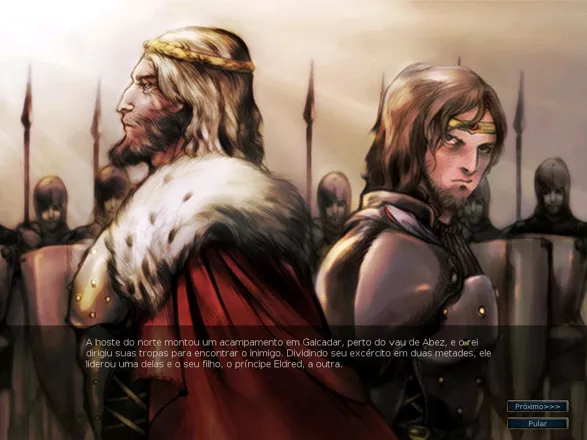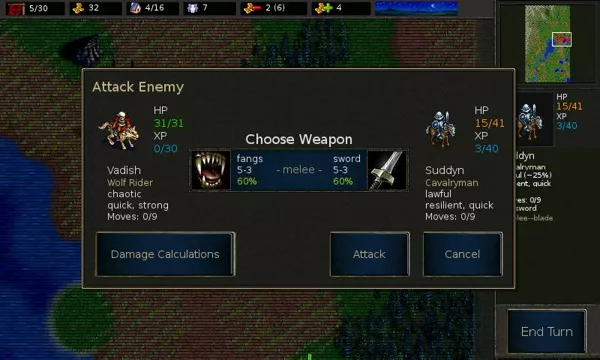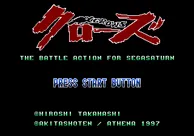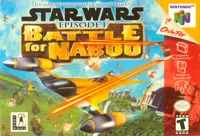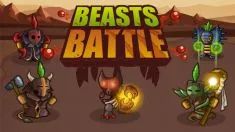The Battle for Wesnoth
Description official descriptions
Battle for Wesnoth is a turn-based fantasy strategy game. Various races - humans, elves, dwarfs, drakes and undead - and various factions battle for the control of the land of Wesnoth in various eras.
The strategic gameplay is similar to games such as Master of Monsters and Warsong. The players, represented in game as high-level commander units, recruit new units, who then fight, advance in experience and eventually turn to another units.
There's both a multiplayer mode, which typically involves wiping out the enemy (or at least their commander). For single player games, there are several campaigns as well as ability to play multiplayer mode against the computer. Also included is a map editor and a scripting language to construct new campaigns.
Groups +
- Fantasy creatures: Dwarves
- Fantasy creatures: Elves
- Fantasy creatures: Goblins
- Fantasy creatures: Griffins
- Fantasy creatures: Mermaids / Merpeople
- Fantasy creatures: Orcs
- Fantasy creatures: Trolls
- Game feature: Hexagonal map
- Gameplay feature: Day / night cycle
- Games that include map/level editor
- Games with officially released source code
- Middleware: SDL
Screenshots
Promos
Videos
Add Trailer or Gameplay Video +1 point
See any errors or missing info for this game?
You can submit a correction, contribute trivia, add to a game group, add a related site or alternate title.
Credits (Windows version)
768 People (741 developers, 27 thanks) · View all
| Lead Developer |
|
| Coder |
|
| Autotools |
|
| [ full credits ] | |
Reviews
Critics
Average score: 84% (based on 20 ratings)
Players
Average score: 4.2 out of 5 (based on 45 ratings with 4 reviews)
Flipping a coin is not much of a tactic, is it?
The Good
This game deserves praise, and Curlymcdom's review touches all the right points. In short the game provides an unique tactical variety that forces a deep strategical thinking on the player from the very start.
You start your battle in an immovable fort from which you can recruit units for gold, of which you have a limited amount. Gold is acquired by gaining control of villages (which pull double and triple duty as a healing center and a fortified location for most units) making the frame for a simple, yet enjoyable economic king-of-the-hill game where each opponent tries to hold on as much villages as possible without compromising their overall defenses. Speaking of which - your goal is very simple: Kill the other leader. Simple, however, is by no means easy since the leader is usually a high level unit that can hold their own against a host of low level grunts. Although you need the leader in a specific part of your fort to recruit new soldiers, most commanders will move their leader, either to capture villages early on (particularly if you have a very mobile leader) or let the leader follow the initial wave of your troops in the hope of turning the tables at a key point with its awesome presence (if you have a more battle oriented leader).
What makes this game stand out is the huge diversity of the units you can recruit. Each unit has different movement and defense properties on different terrains, as well as different attacks that affect different troops differently. Well, that sentence wasn't very clear, but here is an example from the game: A human horseman is extremely fast on open, flat grassland and can outrun almost any other unit. It also has a very powerful attack that, combined with the horseman's speed, can kill a unit the moment it's seen. However there is a down side - power comes at the cost of defense and once your opponent's turn comes up you might discover that the initial weak troop was a mere distraction to lure your horseman closer to the slower enemy soldiers who can dispatch it easily with ranged attacks against which the horseman cannot retaliate. This is not the only possible scenario too. Suppose you order your horseman to attack a skeleton on a mountain. Now the situation is reversed - the horseman that was fast on grassland, will barely be able to climb the mountain, and even there the horseman's piercing attack will do little damage to a skeletal body, where as the skeleton will use the horseman's momentum against him, striking the rider down where it stands.
In a game with a dozen terrain types, two basic attacks (melee or ranged) but half a dozen attack types (from piercing to arcane) and a countless host of units every location is a potential threat or an opportunity. All depending on your strategical at the start when you purchased your units and plotted their course. A mountain trail would benefit some units, while a forest grove will support a completely different set.
If that wasn't enough, units can also gain experience from battle and evolve into stronger versions with even more possibilities! A human spearman can choose to evolve into a powerful offensive swordsman, a defensively oriented pikeman or a ranged based javalineer. Each unit is stronger than the basic spearman, but each one has completely different role on the battlefield. It's up to you to decide which evolution path is best suited to what situation. Thankfully, the game provides an encyclopedia that completely describes all possible attributes of your recruits or their upgrades, from defensive and movement properties in every terrain to their attacks and abilities (almost all of which are useful in their own way). Furthermore, the game will also give you the same information about visible enemy units, as well as providing a statistical prediction of the result of any fight between two units. These options are excellently integrated into the turn based gameplay so that you are never discouraged or inconvenienced when you try to decide on a possible approach.
All in all, the good part of the game is quite polished and well presented. Even the graphics aren't much of a problem - the little sprites looks very natural in this setting adding, rather than subtracting, from the general experienced. The large community that provides user made maps, campaigns and units is just the icing on the proverbial cake.
The Bad
Nevertheless, all of the above is undermined by one simple issue - luck based combat. It's hard to say what went through the head of the designer who is responsible for this poor decision, but the love child of an excellent strategical setting and tactics that are nothing more than a throw of the dice is a deformity that can barely make a few steps before falling over drooling.
Since I started with a horseman example above, I'll use the same one here: The chance to hit any unit in the game or be hit by it is between 40% and 70% (and extremely poorly placed unit has an 80% chance of being hit). On average you have about 50% to hit or be hit. That wouldn't be much of a problem if the damage done was significantly lower than the overall health of the unit, but mostly that's not the case. The horseman form my example for one, has a chance of 75% to kill most weak units, or 25% to kill a stronger unit on its charge (because it delivers two very powerful blows). This means that if you're lucky a group of horsemen can instantly kill two or three enemies. On the other hand you could get unlucky and the horseman's charge will be wasted while on the next turn you'll see your entire troop of horsemen destroyed by a counter-attack from a much more inferior forces. "Don't use horsemen then" you could say. "Limit yourself to units with lower damage but better defense" you could argue. That, however, only shifts the problem slightly. I really can't count the times where a unit was surrounded by six other units and still held its own through the magic of statistics. Or when a high level magical unit (always 70% to any hit on any terrain against any enemy) couldn't score a single hit against a much weaker opponent, while the opponent in question was gleefully chipping away my behemoth's health. On average that doesn't happen. On average the horsemen do more damage than they take. On average strong unit destroy the weak and swarming tactics are an excellent way to destroy a stronger target. But an average is a complex thing that demand endless amount of tries, whereas any single game could have a 95% successful outcome succeed only once in ten tries (yes, that happened to me too).
It could go the other way too, of course, and you can see your frustrating enemy lose soldier after soldier trying to finish off your mortally wounded unit. As humorous as that might be, it goes to show just how much any strategy can be undermined by poorly designed tactics. Not that great strategical games don't have a luck component, they do it to spice things up. But just as a dish could be over spiced, so could a strategy game be ruined when it relies too heavily on luck.
Other than the above there isn't much bad with this game. Anything else is just nitpicking (which include some poorly made campaigns). But then again, it doesn't take much to ruin a game for me. In my mind a strategy game should be a test of wits or skill, not whether I feel like a lucky punk today. When I fail I like to know that it's because of my own shortcomings in developing a sound strategy, not because I lost a roll of dice. Had I wanted that I could have played Yahtzee or something.
The Bottom Line
It's a perfect game for those who enjoy both luck and strategy, but less appealing to anyone else. The main story line isn't compelling enough to push you forward despite yourself, nor is it any worse than the plot of many other games.
The game is quite solid and certain of what it wants to be, it's just that it may not be appealing to some strategy fans, nor is likely to convert anyone new to the genre.
Overall it's a niche game, but one that fills its niche masterfully.
Windows · by Alex Z (1856) · 2012
Not that great compared to other games in the genre
The Good
- Lengthy campaign
- Turn-based tactics
- It's free
The Bad
- I don't like the regenerating units mechanic, and would prefer a fixed number of units and a set number of reinforcements
- Ranged attacks aren't actually ranged in any way
- Few tactical options when compared to turn-based tactics classics like X-COM or Titans of Steel
The Bottom Line
If you want a game with light strategy/tactics in the vein of games found on handheld consoles, then you might like this game. There was not enough depth to hold my interest for long, however.
Windows · by SharkD (425) · 2010
A desperate battle for the throne of Wesnoth, and an endless number of adventures!
The Good
Battle for Wesnoth recalls the golden age of PC strategy games. If you like to have control of an army, will love the various quests in the game.
The Bad
Initially, the game has a few campaigns, but you can increase your Battle for Wesnoth downloading more adventures. Oh, and the graphics are very simple.
The Bottom Line
What is the most important feature of a good game, lush graphics and an engaging strategy that holds on the keyboard? If you also prefer a well-designed game, your game is Battle for Wesnoth, an addictive saga that will test all your skills as a general. Prepare for war, the orcs are on the way and the fate of the castle is in your hands!
Windows · by Perfil Falso (774) · 2011
Trivia
Development
The game was originally designed by David White and a first version was released in July 2003.
Analytics
Upgrade to MobyPro to view research rankings!
Identifiers +
Contribute
Are you familiar with this game? Help document and preserve this entry in video game history! If your contribution is approved, you will earn points and be credited as a contributor.
Contributors to this Entry
Game added by WWWWolf.
BeOS, OS/2 added by 666gonzo666. Macintosh, Android added by chirinea. iPad added by Sciere. Browser, iPhone added by Pseudo_Intellectual. Amiga added by Игги Друге.
Additional contributors: Sciere, Patrick Bregger.
Game added April 5, 2006. Last modified June 20, 2024.




